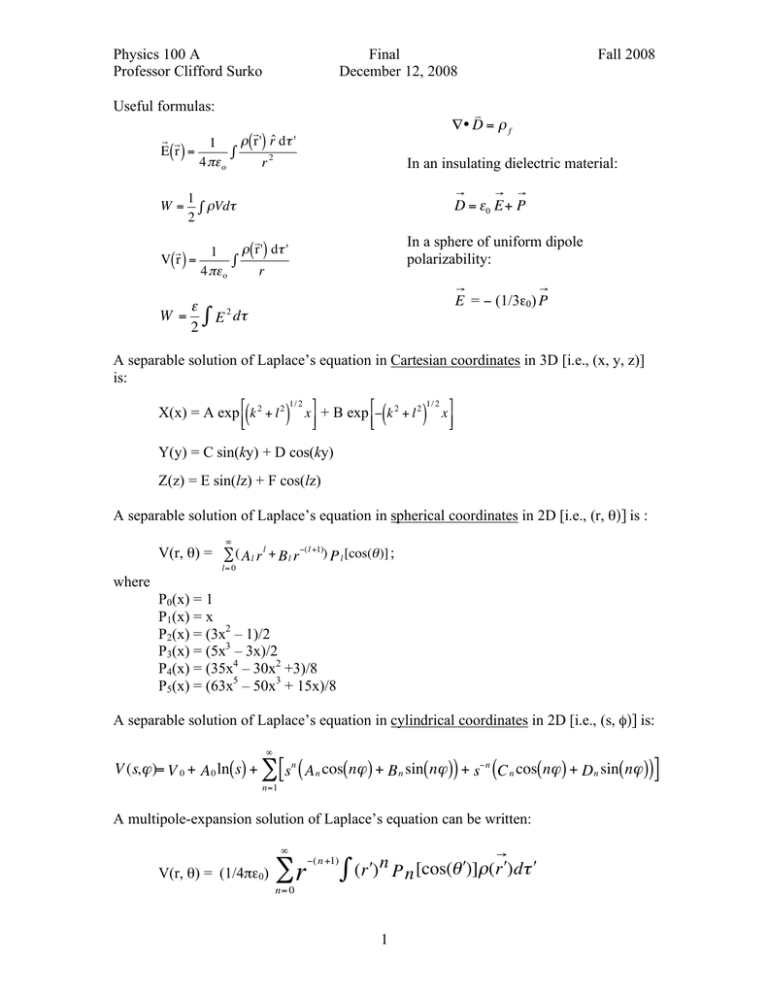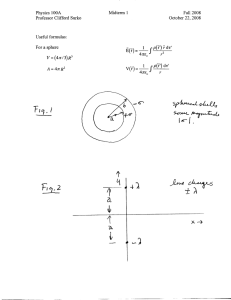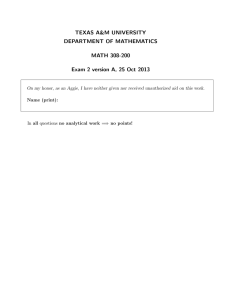Document 10957921
advertisement

Physics 100 A Professor Clifford Surko Final December 12, 2008 Useful formulas: r r E( r ) = W= ! ! v ∇• D = " f r $( r ') rˆ d% ' 1 & 4 "# o r2 In an insulating dielectric material: ! 1 $ "Vd# 2 r V( r ) = Fall 2008 r $( r ') d% ' 1 & 4 "# o r ! " " " D = #0 E + P In a sphere of uniform dipole polarizability: " W = ! ! " 2 $E 2 " E = − (1/3ε0) P d# A separable solution of Laplace’s equation in Cartesian coordinates in 3D [i.e., (x, y, z)] ! ! is: " # ( X(x) = A exp $ k 2 + l 2 1/ 2 ) % # x ' + B exp %" k 2 + l 2 & $ ( 1/ 2 ) & x( ' Y(y) = C sin(ky) + D cos(ky) Z(z)!= E sin(lz) + F cos(lz)! A separable solution of Laplace’s equation in spherical coordinates in 2D [i.e., (r, θ)] is : " V(r, θ) = # ( A l r l + B l r$(l +1)) P l [cos(% )] ; l= 0 where P0(x) = 1 P! 1(x) = x P2(x) = (3x2 – 1)/2 P3(x) = (5x3 – 3x)/2 P4(x) = (35x4 – 30x2 +3)/8 P5(x) = (63x5 – 50x3 + 15x)/8 A separable solution of Laplace’s equation in cylindrical coordinates in 2D [i.e., (s, φ)] is: $ [ V (s," )= V 0 + A 0 ln( s) + % sn ( A n cos( n" ) + B n sin( n" )) + s#n (C n cos( n" ) + Dn sin( n" )) n=1 A multipole-expansion solution of Laplace’s equation can be written: ! # V(r, θ) = (1/4πε ) $ r 0 "( n +1) ( * (r%)n P n [cos(& %)]'(r%)d) % n= 0 1 ! ] 2 Physics 100 A Professor Clifford Surko Final December 12, 2008 Fall 2008 Please note: Be sure to state clearly the reasoning behind your answers. Answers without explanation or supporting work will receive little or no credit. There are 9 problems in this test. All problems count equally, and all parts of any given problem count equally also. 1. This problem relates to Fig. 1. Three charges, A, B, and C, are arranged as shown, with charge and (x, y) coordinates as follows: A: - q at (0, 0) B: + q at (0, a) C: + q at (a, 0). (a) What is the force (magnitude and direction) on charge C, namely + q at (a, 0)? ) ) Use the unit vector notation, x , y , to report your answer. (b) How much work is required (sign and magnitude) to establish this configuration of three charges? ! 2. This problem relates!to Fig. 2. Three thick conducting planes with cross sectional area A = L x L are oriented in the plane perpendicular to the z axis and separated by distances d1 and d2, as shown, where d1 and d2 << L. Conductors X and Z are grounded and Y is raised to potential V0. (a) What is the magnitude of the charge on the three conductors? Draw a careful sketch to show where it is located. State clearly whether it is volume or surface charge. (b) What is the work required to raise conductor Y from potential V = 0 to V0? Express your answer in terms of the geometrical factors and V0. (c) What is the capacitance of conductor Y with respect to the grounded conductors X and Z? 3. This problem relates to Fig. 3. A circular line charge with charge per unit length λ and radius b is centered at the origin and located in the x, y plane, as shown. (a) Compute the electrical potential, V(z) along the z axis assuming V = 0 at r = ∞. r (b) Consider a charge q located on the z axis. Find the force, F (z) , on this charge as a function of z. r r r (c) Plot F (z) as a function of z and find the minimum and maximum values F ( z ) on ! the interval, - ∞ < z < ∞. ! ! 5 Physics 100 A Professor Clifford Surko Final December 12, 2008 Fall 2008 4. This problem relates to Fig. 4. Two conducting planes are oriented at right angles. A line charge with charge per unit length λ is oriented parallel to the surfaces of the planes and placed a distance a away from each, as shown. The planes and line charge are ) infinitely long in the z direction (i.e., perpendicular to the plane of the figure). (a) What is the force per unit length, f, of the planes on the line charge (magnitude ) ) x and direction, using , y notation)? ! (b) How much work per unit length of the line charge is required to move the line charge from (x, y) position (5a, 5a) to the position (a, a)? Explain the sign of your ! answer. ! 5. This problem relates to Fig. 5. A line charge λ(z) is located between z = + a and z = − a. For the specific forms of λ(z) below, state which of the three lowest-order multipoles (i.e., monopole, dipole, and quadrupole), are nonzero and which are zero in magnitude. You do not need to compute the strength of the multipoles, just state the answers and give brief, but clear explanations to support your answers. In denoting the multipoles, you can quote the index, n = 0, 1, or 2, associated with the relevant Legendre polynomial, Pn[cos(θ)]. (a) λ(z) = λ(z)0 sin(πz/a) (b) λ(z) = λ(z)0 cos(πz/a) (c) λ(z) = λ(z)0 sin[π(z + a)/4a] 6. This problem relates to Fig. 6. Two conducting parallel plates of dimension L x L are separated by a distance a << L and are at electrical potential V = 0. A thin charged membrane is inserted perpendicular to the plates at x = 0. The potential on this membrane is V(0, y) = V0sin(πy/a). Both the membrane and the plates extend a distance L in the direction perpendicular to the plane of the figure. (a) Find the electrical potential, V(x, y) in the region between the plates to the right of the membrane (i.e., x > 0). (b) Find the sign and magnitude of the charge density, σ(x) on the conducting plates at y = 0 and y = a to the right of the membrane, namely for x > 0. 6 Physics 100 A Professor Clifford Surko Final December 12, 2008 Fall 2008 7. This problem relates to Fig. 7. An infinitely long cylindrical insulating surface of radius b is charged so that the electrical potential on the surface is V (b, " ) = V o cos(2" ) . (a) Find the electrical potential, V (s, " ) , for s ≤ b. ! r (b) Find the electric field, E (s, " ) , for s ≤ b. ! (c) Find the electrical potential, V (s, " ) , for s ≥ b. ! to Fig. 8. Two parallel conducting plates of cross sectional area A 8. This problem relates = L x L are separated by a distance d, where d << L. They have surface charge densities + σ on the top plate and – σ!on the bottom plate. A linear dielectric material with dielectric constant εr = 2.0 and thickness d/2 lies on top of the lower plate, as shown. (a) What are the electric fields in the vacuum above the dielectric and in the dielectric? (b) What is the voltage difference between the two plates? (c) Where is the bound charge located in the dielectric and what is its magnitude? Draw a sketch showing its location. 9. This problem relates to Fig. 9 on the formula page. A thick spherical shell (inner radius a and outer radius b) is made of dielectric material with a frozen-in polarization, r r P ( r ) = krrˆ . ! (a) Calculate all of the bound charge, indicate clearly both its location and whether it is surface or volume charge density. (b) Find the electric field everywhere in space, 0 ≤ r ≤ ∞. 7

